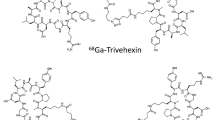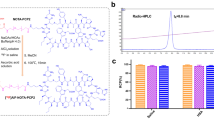Abstract
Purpose
PD-L1 PET imaging, as a non-invasive procedure, can perform a real-time, dynamic and quantitative analysis of PD-L1 expression at tumor sites. In this study, we developed a novel peptide-based PET tracer, [68 Ga]Ga-AUNP-12, for preclinical and first-of-its-kind imaging of PD-L1 expression in patients.
Methods
Radiosynthesis of [68 Ga]Ga-AUNP-12 was conducted. Assays for cellular uptake and binding were conducted on the PANC02, CT26, and B16F10 cell lines. Preclinical models were used to investigate its biodistribution, imaging capacity, and pharmacokinetics. Furthermore, interferon-γ (IFN-γ) was used for development of an animal model with high PD-L1 expression for targeted PET imaging and efficacy evaluation of PD-L1 blocking therapy. In healthy volunteers and cancer patients, the PD-L1 imaging, radiation dosimetry, safety, and biodistribution were further evaluated.
Results
In vitro and in vivo animal studies showed that [68 Ga]Ga-AUNP-12 PET imaging displayed a high specificity in evaluating PD-L1 expression. The radiochemical yield of [68 Ga]Ga-AUNP-12 was 71.7 ± 8.2%. Additionally, its molar activity and radiochemical purity were satisfactory. The B16F10 tumor was visualized with the tumor uptake of 6.86 ± 0.71% ID/g and tumor-to-muscle ratio of 6.83 ± 0.36 at 60 min after [68 Ga]Ga-AUNP-12 injection. Furthermore, [68 Ga]Ga-AUNP-12 PET imaging could sensitively detect the PD-L1 dynamic changes in CT26 tumor xenograft models regulated by IFN-γ treatment, and correspondingly can effectively guide immunotherapy. Regarding radiation dosimetry, [68 Ga]Ga-AUNP-12 is safe for human use. The first human study found that [68 Ga]Ga-AUNP-12 can be rapidly cleared from blood and other nonspecific organs through the kidney excretion, leading to form a clear imaging contrast in the clinical framework. The specificity of [68 Ga]Ga-AUNP-12 was validated and tumor uptake strongly correlated with the high PD-L1 expression in patients with lung adenocarcinoma and oesophageal squamous cell carcinoma (OSCC).
Conclusion
[68 Ga]Ga-AUNP-12 was successfully developed as a PD-L1-specific PET imaging tracer in preclinical and first-in-human studies.






Similar content being viewed by others
Data Availability
The data underlying this article will be shared on reasonable request to the corresponding author.
References
Sung H, Ferlay J, Siegel RL, Laversanne M, Soerjomataram I, Jemal A, et al. Global Cancer Statistics 2020: GLOBOCAN Estimates of Incidence and Mortality Worldwide for 36 Cancers in 185 Countries. CA Cancer J Clin. 2021;71(3):209–49. https://doi.org/10.3322/caac.21660.
Marin-Acevedo JA, Dholaria B, Soyano AE, Knutson KL, Chumsri S, Lou Y. Next generation of immune checkpoint therapy in cancer: new developments and challenges. J Hematol Oncol. 2018;11(1):39. https://doi.org/10.1186/s13045-018-0582-8.
Gavrielatou N, Doumas S, Economopoulou P, Foukas PG, Psyrri A. Biomarkers for immunotherapy response in head and neck cancer. Cancer Treat Rev. 2020;84:101977. https://doi.org/10.1016/j.ctrv.2020.101977.
Topalian SL, Hodi FS, Brahmer JR, Gettinger SN, Smith DC, Mcdermott DF, et al. Safety, activity, and immune correlates of anti-PD-1 antibody in cancer. N Engl J Med. 2012;366(26):2443–54. https://doi.org/10.1056/NEJMoa1200690.
Brahmer JR, Tykodi SS, Chow LQ, Hwu WJ, Topalian SL, Hwu P, et al. Safety and activity of anti-PD-L1 antibody in patients with advanced cancer. N Engl J Med. 2012;366(26):2455–65. https://doi.org/10.1056/NEJMoa1200694.
Gibney GT, Weiner LM, Atkins MB. Predictive biomarkers for checkpoint inhibitor-based immunotherapy. Lancet Oncol. 2016;17(12):e542–51. https://doi.org/10.1016/S1470-2045(16)30406-5.
Shukuya T, Carbone DP. Predictive Markers for the Efficacy of Anti-PD-1/PD-L1 Antibodies in Lung Cancer. J Thorac Oncol. 2016;11(7):976–88. https://doi.org/10.1016/j.jtho.2016.02.015.
Zhao X, Bao Y, Meng B, Xu Z, Li S, Wang X, et al. From rough to precise: PD-L1 evaluation for predicting the efficacy of PD-1/PD-L1 blockades. Front Immunol. 2022;13:920021. https://doi.org/10.3389/fimmu.2022.920021.
Du Y, Qi Y, Jin Z, Tian J. Noninvasive imaging in cancer immunotherapy: The way to precision medicine. Cancer Lett. 2019;466:13–22. https://doi.org/10.1016/j.canlet.2019.08.009.
Du Y, Jin Y, Sun W, Fang J, Zheng J, Tian J. Advances in molecular imaging of immune checkpoint targets in malignancies: current and future prospect. Eur Radiol. 2019;29(8):4294–302. https://doi.org/10.1007/s00330-018-5814-3.
Bensch F, van der Veen EL, Lub-De HM, Jorritsma-Smit A, Boellaard R, Kok IC, et al. (89)Zr-atezolizumab imaging as a non-invasive approach to assess clinical response to PD-L1 blockade in cancer. Nat Med. 2018;24(12):1852–8. https://doi.org/10.1038/s41591-018-0255-8.
Cole EL, Kim J, Donnelly DJ, Smith RA, Cohen D, Lafont V, et al. Radiosynthesis and preclinical PET evaluation of (89)Zr-nivolumab (BMS-936558) in healthy non-human primates. Bioorg Med Chem. 2017;25(20):5407–14. https://doi.org/10.1016/j.bmc.2017.07.066.
Christensen C, Kristensen LK, Alfsen MZ, Nielsen CH, Kjaer A. Quantitative PET imaging of PD-L1 expression in xenograft and syngeneic tumour models using a site-specifically labelled PD-L1 antibody. Eur J Nucl Med Mol Imaging. 2020;47(5):1302–13. https://doi.org/10.1007/s00259-019-04646-4.
Smit J, Borm FJ, Niemeijer AN, Huisman MC, Hoekstra OS, Boellaard R, et al. PD-L1 PET/CT Imaging with Radiolabeled Durvalumab in Patients with Advanced-Stage Non-Small Cell Lung Cancer. J Nucl Med. 2022;63(5):686–93. https://doi.org/10.2967/jnumed.121.262473.
Hu K, Xie L, Hanyu M, Zhang Y, Li L, Ma X, et al. Harnessing the PD-L1 interface peptide for positron emission tomography imaging of the PD-1 immune checkpoint. RSC Chem Biol. 2020;1(4):214–24. https://doi.org/10.1039/d0cb00070a.
Kist DRL, Hooiveld-Noeken JS, Giesen D, Lub-De HM, Kok IC, Brouwers AH, et al. First-in-Human Study of the Biodistribution and Pharmacokinetics of 89Zr-CX-072, a Novel Immunopet Tracer Based on an Anti-PD-L1 Probody. Clin Cancer Res. 2021;27(19):5325–33. https://doi.org/10.1158/1078-0432.CCR-21-0453.
Kumar D, Lisok A, Dahmane E, Mccoy M, Shelake S, Chatterjee S, et al. Peptide-based PET quantifies target engagement of PD-L1 therapeutics. J Clin Invest. 2019;129(2):616–30. https://doi.org/10.1172/JCI122216.
Zhou M, Wang X, Chen B, Xiang S, Rao W, Zhang Z, et al. Preclinical and first-in-human evaluation of (18)F-labeled D-peptide antagonist for PD-L1 status imaging with PET. Eur J Nucl Med Mol Imaging. 2022. https://doi.org/10.1007/s00259-022-05876-9.
Sasikumar PG, Ramachandra RK, Adurthi S, Dhudashiya AA, Vadlamani S, Vemula K, et al. A Rationally Designed Peptide Antagonist of the PD-1 Signaling Pathway as an Immunomodulatory Agent for Cancer Therapy. Mol Cancer Ther. 2019;18(6):1081–91. https://doi.org/10.1158/1535-7163.MCT-18-0737.
Zhao W, Hu X, Li W, Li R, Chen J, Zhou L, et al. M2-Like TAMs Function Reversal Contributes to Breast Cancer Eradication by Combination Dual Immune Checkpoint Blockade and Photothermal Therapy. Small. 2021;17(13):e2007051. https://doi.org/10.1002/smll.202007051.
Gao Y, Yang J, Cai Y, Fu S, Zhang N, Fu X, et al. IFN-gamma-mediated inhibition of lung cancer correlates with PD-L1 expression and is regulated by PI3K-AKT signaling. Int J Cancer. 2018;143(4):931–43. https://doi.org/10.1002/ijc.31357.
Abiko K, Hamanishi J, Matsumura N, Mandai M. Dynamic host immunity and PD-L1/PD-1 blockade efficacy: developments after “IFN-gamma from lymphocytes induces PD-L1 expression and promotes progression of ovarian cancer.” Br J Cancer. 2022. https://doi.org/10.1038/s41416-022-01960-x.
Delbeke D, Coleman RE, Guiberteau MJ, Brown ML, Royal HD, Siegel BA, et al. Procedure guideline for tumor imaging with 18F-FDG PET/CT 1.0. J Nucl Med. 2006;47(5):885–95.
Huisman MC, Niemeijer AN, Windhorst AD, Schuit RC, Leung D, Hayes W, et al. Quantification of PD-L1 Expression with (18)F-BMS-986192 PET/CT in Patients with Advanced-Stage Non-Small Cell Lung Cancer. J Nucl Med. 2020;61(10):1455–60. https://doi.org/10.2967/jnumed.119.240895.
Chatterjee S, Lesniak WG, Miller MS, Lisok A, Sikorska E, Wharram B, et al. Rapid PD-L1 detection in tumors with PET using a highly specific peptide. Biochem Biophys Res Commun. 2017;483(1):258–63. https://doi.org/10.1016/j.bbrc.2016.12.156.
Niemeijer AN, Leung D, Huisman MC, Bahce I, Hoekstra OS, van Dongen G, et al. Whole body PD-1 and PD-L1 positron emission tomography in patients with non-small-cell lung cancer. Nat Commun. 2018;9(1):4664. https://doi.org/10.1038/s41467-018-07131-y.
Jouini N, Cardinale J, Mindt TL. Evaluation of a Radiolabeled Macrocyclic Peptide as Potential PET Imaging Probe for PD-L1. Chemmedchem. 2022;17(12):e202200091. https://doi.org/10.1002/cmdc.202200091.
Hu K, Kuan H, Hanyu M, Masayuki H, Xie L, Zhang Y, et al. Developing native peptide-based radiotracers for PD-L1 PET imaging and improving imaging contrast by pegylation. Chem Commun (Camb). 2019;55(29):4162–5. https://doi.org/10.1039/c9cc00445a.
Sun P, Han Y, Hu K, Huang S, Wang M, Zhou K, et al. Synthesis and biological evaluation of Al[(18)F]-NOTA-IPB-PDL1P as a molecular probe for PET imaging of PD-L1 positive tumors. Bioorg Chem. 2022;122:105682. https://doi.org/10.1016/j.bioorg.2022.105682.
Zhan MM, Hu XQ, Liu XX, Ruan BF, Xu J, Liao C. From monoclonal antibodies to small molecules: the development of inhibitors targeting the PD-1/PD-L1 pathway. Drug Discov Today. 2016;21(6):1027–36. https://doi.org/10.1016/j.drudis.2016.04.011.
Alspach E, Lussier DM, Schreiber RD. Interferon gamma and Its Important Roles in Promoting and Inhibiting Spontaneous and Therapeutic Cancer Immunity. Cold Spring Harb Perspect Biol. 2019;11(3). https://doi.org/10.1101/cshperspect.a028480.
Conti M, Eriksson L. Physics of pure and non-pure positron emitters for PET: a review and a discussion. EJNMMI Phys. 2016;3(1):8. https://doi.org/10.1186/s40658-016-0144-5.
Funding
This study was financially supported by the National Natural Science Foundation of China (Grant numbers 82272111, 92159303, 62027901, 82272045, 91859207, 81771873 and 82002887), the Beijing Natural Science Foundation (Grant number 7212207), the Science and Technology Innovation Team Talent Project of Hunan Province (Grant number 2021RC4056), the Natural Science Foundation of Hunan Province (Grant numbers 2023JJ30976).
Author information
Authors and Affiliations
Contributions
Conception, design and supervision by Yang Du, Jie Tian and Shuo Hu. Methodology was provided by Ming Zhou and Yang Du. Material preparation, data collection and analysis were performed by Shijun Xiang, Xiaoqin Yin, Jinhui Yang and Yongxiang Tang. The first draft of the manuscript was written by Yajie Zhao and all authors commented on previous versions of the manuscript. All authors read and approved the final manuscript.
Corresponding authors
Ethics declarations
Competing interests
The authors have no relevant financial or non-financial interests to disclose.
Ethics approval
All clinical studies were approved by the Medical Ethics Committee of Xiangya Hospital, Central South University (No. 202106115). All animal studies were performed according to the guidelines of the Animal Care Committee of Central South University (CSU-2022–0290).
Additional information
Publisher's Note
Springer Nature remains neutral with regard to jurisdictional claims in published maps and institutional affiliations.
Supplementary Information
Below is the link to the electronic supplementary material.
Rights and permissions
Springer Nature or its licensor (e.g. a society or other partner) holds exclusive rights to this article under a publishing agreement with the author(s) or other rightsholder(s); author self-archiving of the accepted manuscript version of this article is solely governed by the terms of such publishing agreement and applicable law.
About this article
Cite this article
Zhou, M., Xiang, S., Zhao, Y. et al. [68Ga]Ga-AUNP-12 PET imaging to assess the PD-L1 status in preclinical and first-in-human study. Eur J Nucl Med Mol Imaging 51, 369–379 (2024). https://doi.org/10.1007/s00259-023-06447-2
Received:
Accepted:
Published:
Issue Date:
DOI: https://doi.org/10.1007/s00259-023-06447-2




